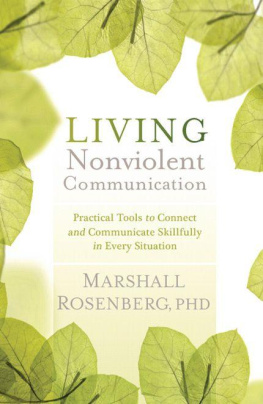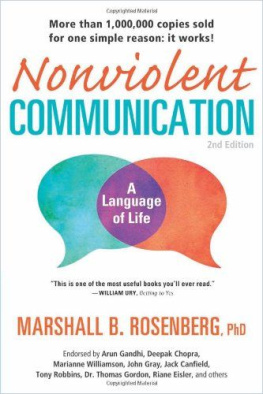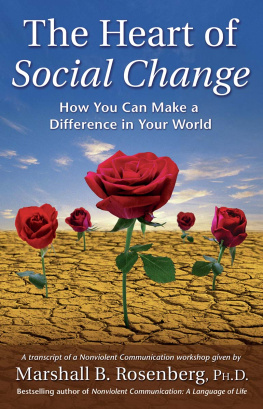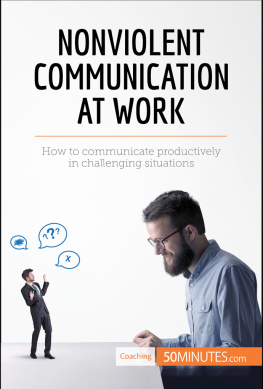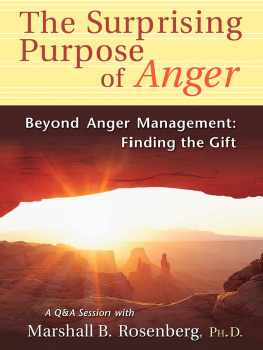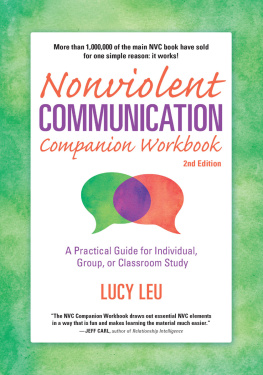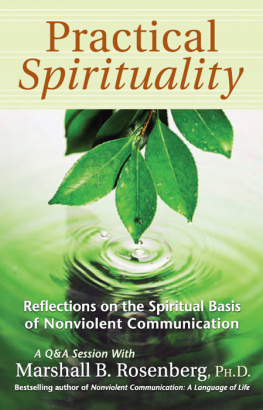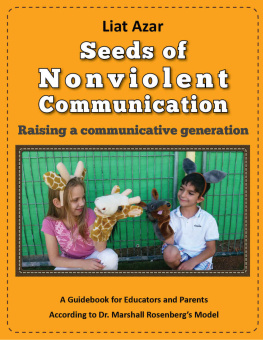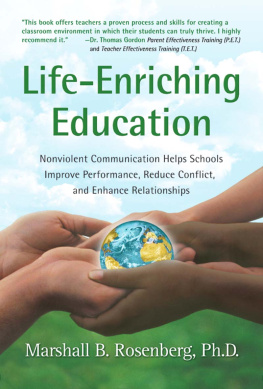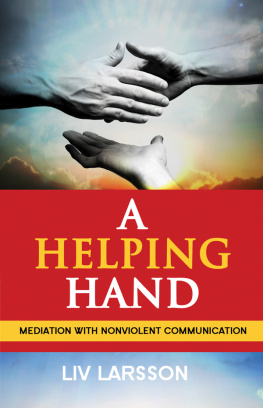
LIVING
Nonviolent
Communication
Practical Tools to Connect
and Communicate Skillfully
in Every Situation
MARSHALL
ROSENBERG, PhD


C ONTENTS

A DDITIONAL P RAISE FOR
M ARSHALL R OSENBERG , P H D
We should all be grateful to Marshall Rosenberg. He provides us with the most effective tools to foster health and relationships. Nonviolent Communication connects soul to soul, creating a lot of healing and helps us express honestly from the heart what are people doing that is or is not in harmony with our needs. NVC is the missing element in what we do.
Deepak Chopra ,
author of Ageless Body, Timeless Mind
Dr. Rosenberg has brought the simplicity of successful communication into the foreground. No matter what issue youre facing, his strategies for communicating with others will set you up to win every time.
Anthony Robbins ,
author of Awaken the Giant Within and Unlimited Power
Written with a profound level of clarity and compassion known only to those who practice what they preach, Marshalls Living Nonviolent Communication opens us to give our hearts willing consent to communicate in ways that foster authentic trust and intimate connection both with ourselves and in all forms of relationship.
Michael Bernard Beckwith ,
author of Life Visioning: A Transformative Process
for Activating Your Unique Gifts and Highest Potential


A B RIEF I NTRODUCTION TO
N ONVIOLENT C OMMUNICATION
N onviolent Communication, or NVC, is a powerful model of communication, but it goes far beyond that. It is a way of being, thinking, and living in the world. Its purpose is to inspire heartfelt connections between ourselves and other peopleconnections that allow everyones needs to be met through compassionate giving. It inspires us and others to give from the heart. It also helps us connect to our inner divinity and to what is alive in us moment to moment.
We could say that NVC is a language of compassion, but it is really a language of life in which compassion comes naturally. The model shows us how to express what is alive in us and to see what is alive in other people. Once we get clear about what is alive in us, we can look at what we can do to enrich that life.
Nonviolent Communication evolved out of an intense interest I had in two questions. First, I wanted to better understand what happens to human beings that leads some of us to behave violently and exploitatively. And second, I wanted to better understand what kind of education serves our attempts to remain compassionatewhich I believe is our nature even when others are behaving violently or exploitatively. The theory that has been around for many centuries says that violence and exploitation happen because people are innately evil, selfish, or violent. But I have seen people who arent like that; I have seen many people who enjoy contributing to one anothers well-being. So, I wondered why some people seem to enjoy other peoples suffering, while other people are just the opposite.
Some Basic Feelings We All Have
Feelings When Needs
Are Fulfilled | Feelings When Needs
Are Not Fulfilled |
| Amazed | Angry |
| Comfortable | Annoyed |
| Confident | Concerned |
| Eager | Confused |
| Energetic | Disappointed |
| Fulfilled | Discouraged |
| Glad | Distressed |
| Hopeful | Embarrassed |
| Inspired | Frustrated |
| Intrigued | Helpless |
| Joyous | Hopeless |
| Moved | Impatient |
| Optimistic | Irritated |
| Proud | Lonely |
| Relieved | Nervous |
| Stimulated | Overwhelmed |
| Surprised | Puzzled |
| Thankful | Reluctant |
| Touched | Sad |
| Trustful | Uncomfortable |
In my exploration of these two questions, I found that the following three factors are very important in understanding why some of us respond violently and some of us respond compassionately in similar situations:
The language that we have been educated to use
How we have been taught to think and communicate
The specific strategies we have learned to influence others and ourselves
Some Basic Needs We All Have
| Autonomy |
Choosing ones dreams, goals,
and values | Choosing ones plan for fulfilling
thoses dreams, goals, and values |
| Celebration |
Celebrating the creation of life
and dreams fulfilled | Celebrating losses of loved ones,
dreams, and so on (mourning) |
| Integrity |
| Authenticity | Meaning |
| Creativity | Self-worth |
| Interdependence |
| Acceptance | Honesty (the empowering honesty
that enables us to learn from
our limitations) |
| Appreciation |
| Closeness | Love |
| Community | Reassurance |
| Consideration | Respect |
Contributing to the enrichment of life
(exercising ones power by giving
that which contributes to life) | Support |
| Trust |
| Emotional safety | Understanding |
| Empathy | Warmth |
| Physical Nurturance |
| Air | Rest |
| Food | Sexual expression |
| Movement and exercise | Shelter |
Protection from life-threatening forms
of life, such as viruses, bacteria,
insects, predator y animals, and so on | Touch |
| Water |
| Play |
| Fun | Laughter |
| Spiritual Communion |
| Beauty | Order |
| Harmony | Peace |
| Inspiration |
Because these three factors play a large role in determining whether we are able to respond compassionately or violently in situations, I have integrated the type of language, the kinds of thinking, and the forms of communication that strengthen our ability to willingly contribute to our own well-being and the well-being of others into this process that I call Nonviolent Communication.
The NVC process shows us how to nakedly express how we are and what is alive in uswithout any criticism and without any analysis of others that implies wrongness. The process is based on the assumption that anything that people hear from us that sounds like an analysis or a criticism, or that implies wrongness on their part, prevents us from connecting with them in a way that allows everyone to contribute to one anothers well-being. This approach to communication emphasizes compassionrather than fear, guilt, shame, blame, coercion, or threat of punishmentas the motivation for action. In other words, it is about getting what we want for reasons that we will not regret later. Part of the process is to say clearly, without analysis, criticism, or blame, what is alive in us. Another part is to say clearly what would make life more wonderful for us and to present this information to others as requests and not as demands.
Next page
